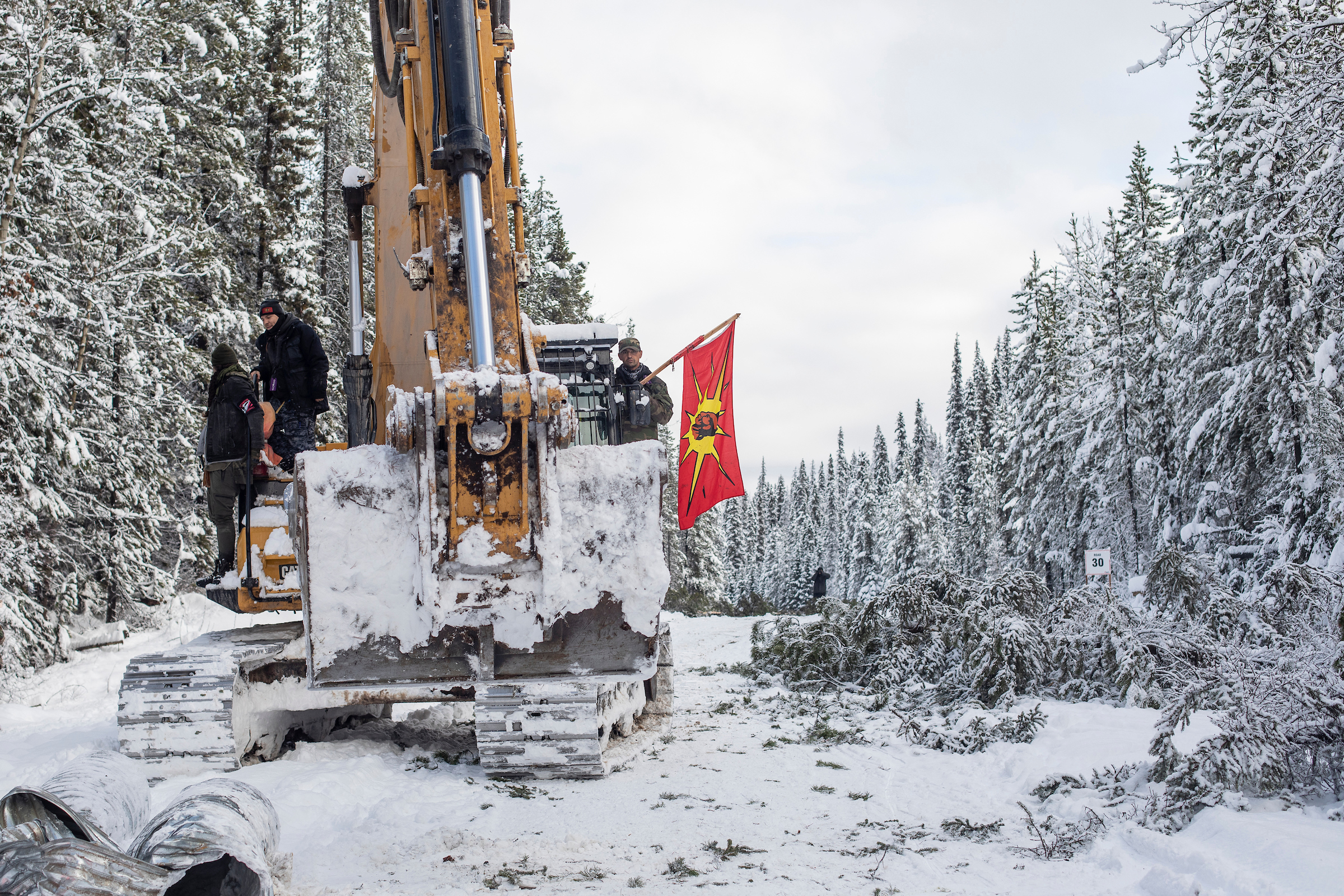On the evening of November 17, @Gidimten—the Twitter account of the Gidimt’en Checkpoint, a camp on Wet’suwet’en land in British Columbia—posted an update to its followers. The Supreme Court of British Columbia had previously granted an injunction to facilitate development of a Coastal GasLink pipeline project on the land, against the wishes of hereditary chiefs and their supporters. Now Royal Canadian Mounted Police had established an exclusion zone ten kilometers from the camp; according to the update, officers were “blocking Wet’suwet’en people, hereditary chiefs, food, medical supplies, and journalists” from the site. A video followed; in it, Jennifer Wickham, media coordinator for the Gidimt’en Checkpoint, is stopped by police, who say that the access road leading to the checkpoint will be shut down “for the next two or three days.” The next morning, the account reported sightings of RCMP and Coastal GasLink personnel, adding, “Will attempt to keep updated on the latest here.”
Over the next two days, the Gidimt’en Checkpoint posted a series of updates as RCMP officers enforced the court injunction. Those posts relayed crowdsourced reports of police actions, photo and video updates from the ground, and requests for solidarity actions—from hosting rallies to pressuring pipeline investors to calling provincial and federal government officials—to the account’s twenty-nine thousand followers. Amanda Follett Hosgood, a reporter for The Tyee, an outlet based in British Columbia, wrote on Twitter at the time, “If you’re not already following @Gidimten this is the best way to get updates…”
Several people on-site recorded the arrests of land defenders. In one video, police in tactical gear advance upon a group of defenders huddled in song and prayer around a Wet’suwet’en elder, and arrest them one by one. A voice can be heard yelling, “I’m media! I’m media!” Near the video’s end, a caption reads, “15 people were arrested including two Wet’suwet’en elders, 3 Haudenosaunee members, 3 Legal Observers, and one journalist.”
Another, shot by Michael Toledano, a filmmaker working on a documentary for the Canadian Broadcasting Corporation, begins inside a tiny, shed-size cabin, where he and Amber Bracken, a photojournalist for The Narwhal, are with five land defenders. In the footage, police can be seen scouring the camp. There’s a din of shouting, barking, and machinery in the background; then comes the crack of an ax against a door, followed by the sound of a chainsaw as it cuts through the door of the cabin. A rifle is visible through the gap in the door. “Get your fucking gun off me!” Sleydo’, a land defender, says. The rifle stays on the group. And then, one by one, those inside the cabin, including Toledano, are grabbed by police, forced out of the cabin, and arrested. Following his release from custody, Toledano wrote that he would be “publishing this footage as soon as possible.”
Both videos were released via the Gidimt’en Checkpoint Twitter account in the days following the arrests. On the morning of November 24, the account posted a two-minute edit of Toledano’s footage, along with text offering a longer, unedited clip to “news organizations that want access.” By day’s end, video of the arrests led news outlets across Canada and beyond, including the Toronto Star, Democracy Now, and a host of others. The CBC aired nearly seven minutes of film by Toledano, during which Toledano is heard telling a police officer that he is “filming a documentary for CBC television.” “No problem,” an officer replies. “You’re under arrest.”
Gidimt’en Checkpoint was established in December 2018 by the Gidimt’en clan, with the support of each of the five Wet’suwet’en clans. Wet’suwet’en land defenders—a group of people including Wet’suwet’en citizens, allies from other First Nations, and non-Indigenous supporters—are opposed to the construction of the Coastal GasLink pipeline and want to halt unauthorized incursions and construction on territory that was never legally handed over to Canada. Since the checkpoint’s establishment, however, ongoing coverage of the Wet’suwet’en resistance has been hard to come by. The land-defense camps themselves are remote, located off logging roads, with no reliable cell service. Exclusion zones set up by the RCMP—tactics that have been challenged in court—further limit access to the camps, including for reporters. National media has mainly prioritized coverage of the resistance when conflict flares; local media, which includes a handful of rural town papers owned by one publisher, has on occasion dubbed the land defenders “dissidents” and, like other outlets around the country, relied on syndicated content from the Canadian Press.
As it is, newsrooms don’t necessarily prioritize sustained, nonviolent opposition in editorial decision-making. “The public eye wants violence and destruction, but turns away from our quiet resistance,” wrote Anne Spice, a Tlingit sociologist, and Denzel Sutherland-Wilson, a Gitxsan land defender, in the New Inquiry in 2019. “People are less interested in our governance systems operating as they should.”
Though the lands of the Wet’suwet’en Nation are unceded—a fact recognized by Canada’s Supreme Court in a 1997 ruling—conflicts between the Wet’suwet’en and industry, provincial, and federal forces have been unfolding for years. Media coverage was largely reserved for brief moments of arrests and physical engagement. That began to change in February 2020, when RCMP raids on Wet’suwet’en territory drew national media attention and sparked solidarity movements across the country.
“There was this buildup of militarized RCMP that happened, and people could see it, so that gave mainstream media plenty of time to get organized and get reporters out there,” Franklin López, an independent filmmaker, says. RCMP officers also detained or turned away several journalists who were present to document Wet’suwet’en opposition; since then, similar dynamics have played out between law enforcement authorities and journalists at land-defense protests around the country.
Through its social media accounts, the Gidimt’en Checkpoint alerts newsrooms and others to updates from the ground. A post from October 2020 shows hunting efforts interrupted by encounters with pipeline employees and police; others, from late last year, show the peaceful occupation of a drill-pad site, where a cabin has been constructed, or warn of archaeological sites imperiled by the pipeline’s path. Such updates may not necessarily spur coverage from the broader Canadian media ecosystem; still, they are often the only lens into the Wet’suwet’en land-defense community between moments of heightened conflict. (The Gidimt’en Checkpoint website also includes a Wet’suwet’en 101 media backgrounder for journalists trying to get up to speed on the struggle.)
The content published by Gidimt’en Checkpoint comes together from different sources at camp, Wickham says. Some is from trained videographers; some is created by people using cellphone cameras, GoPros, or scrappy camcorders. Once footage is compiled, it goes through a review process, during which a few people handy with editing consult with Wet’suwet’en leadership on key moments to include. Given time limits on certain platforms, there’s pressure to keep video reports concise and hard-hitting. Editing is carried out on-site, in tiny cabins; edited videos are uploaded via satellite internet.
There’s a “colossal distance” between the Gidimt’en Checkpoint resources and “an extractive industry that has probably millions of dollars in the media budget,” Wickham says. (The Coastal GasLink project is valued at $6.6 billion.) The land defenders at Gidimt’en Checkpoint, she says, are working with cellphones and “laptops held together with duct tape.”
Neighboring First Nations maintain their own media projects, some in solidarity with their Wet’suwet’en neighbors. In the town of New Hazelton, a few hours north of Gidimt’en in Gitxsan Nation territory, Gitxsan allies have set up rail blockades and a community camp. The camp, established on November 18, 2021, has also been raided by the RCMP. In November, officers arrested Denzel Sutherland-Wilson, who coauthored the New Inquiry essay. A land defender was present to record the arrest; in footage, Sutherland-Wilson can be heard yelling that he can’t breathe. Footage of the arrest was shared on a Gitxsan account called Git’luuhl’um’hetxwit Media, which often shares @Gidimten’s work and vice versa. Within days, several Canadian news outlets covered Sutherland-Wilson’s arrest, embedding the video footage in their stories.
“It honestly feels at times like you’re fighting an information war,” says Kolin Sutherland-Wilson, Denzel’s brother, a Gitxsan land defender and spokesperson for his wilp. “Often documenting on social media is our only avenue for actually telling the stories of what we’re dealing with.”
Kolin, who has been involved in land defenders’ documentary efforts, taught himself to edit video on Premiere Pro, and has shared work through Git’luuhl’um’hetxwit Media. Rural communities in British Columbia around Gitxsan and Wet’suwet’en are served by local papers; several are published by Black Press, whose founder, David Black, years ago met with a provincial press council to discuss his papers’ editorial policy and his own opposition to a treaty recognizing the Nisga’a Nation’s rights to its territory, and who once proposed construction of a bitumen refinery—a $13.2 billion project necessitating a pipeline like the one Coastal GasLink hopes to build—in Kitimat, on the British Columbian coast. While those papers have covered defenders’ opposition to the pipeline, including Denzel Sutherland-Wilson’s arrest, their publisher’s previous stances leave Kolin skeptical of their commitment to covering Gitxsan and Wet’suwet’en sovereignty.
Earlier this year, Hosgood, the Tyee reporter, revealed that security personnel for Coastal GasLink had attempted to turn away journalists covering Gidimt’en. “Three years into the dispute that has made international headlines, seen dozens of people arrested and caused the high-profile three-day detention of two journalists taken into custody at this site in November, the person tasked with enforcing the injunction on behalf of Coastal GasLink appears not to understand its contents,” she wrote.
Hosgood is based in Smithers—about an hour and a half by car from the RCMP checkpoints near Gidimt’en, closer than many other reporters. She has traveled to the site on several occasions; on November 18, she made the trek to the logging road, where, she says, her efforts to gain access were delayed and initially rejected by an RCMP officer. When she was finally escorted up the logging road, it was just in time to see police processing the people they had arrested. She says she spent hours on Twitter refreshing @Gidimten for updates.
“They were the best source of information,” Hosgood says. “Having a video of what took place gives you a starting point: it helps you visualize what happened and determine what questions need to be asked.”
Last week, posts from the @Gidimten account detailed a series of recent RCMP visits to the site. Following the posts, Matt Simmons—a journalist for The Narwhal who, like Hosgood, is based in Smithers—traveled to the site to speak with land defenders, narrowly missing a visit by RCMP officers. “During times when the conflict between land defenders, industry, and RCMP escalates, the presence of people filming interactions on the ground and sharing them widely helps inform my decision on when I should be physically present to document,” Simmons tells CJR via email. “Gidimt’en Checkpoint social media posts—especially video footage—have repeatedly proved useful to my reporting, in that it’s a relatively easy way to stay informed on ongoing developments, without having to invest a significant amount of time heading out to the location in-person.”
Hosgood adds that the information shared via the @Gidimten account and others like it can be crucial in a conflict whose participants don’t necessarily share information readily. She says she filed a Freedom of Information Act request to access RCMP body-camera footage from the November arrests, but so far has not heard back. “Gidimt’en and other social media accounts like that are providing information that other sources just don’t,” she says.
Accounts such as @Gidimten provide some measures of safety and accountability, Wickham, the checkpoint media coordinator, says. They are also the only way, sometimes, to tell the news. “We’re left with the folks that are actually on the ground, being arrested, and being invaded to document in whatever way they’re able,” she says.
Luke Ottenhof is a freelance writer based in Toronto, Ontario. His work has been published by The Guardian, Globe and Mail, Pitchfork, and CBC.


